You want to learn piano, but you’re tired of spending long hours on learning music notes. So, the first and foremost thing you need to do is to clear away this negative thought instantly if you’re really serious about learning this instrument.
Learning how to play piano or play keyboard, particularly for dummies like you, definitively takes time.
Of course, you need to learn music notes so that you can play piano songs in the future.
Below is a step-by-step tutorial that is suitable for all ages. You will be taught how to get familiar with the music notes, how to read music, how to choose the right piano and lots of other things that make you ready to learn to play the piano.
Be sure to read all steps from beginning to end and soon you can serenade your family and friends at home or even play like a pro. Let’s start!
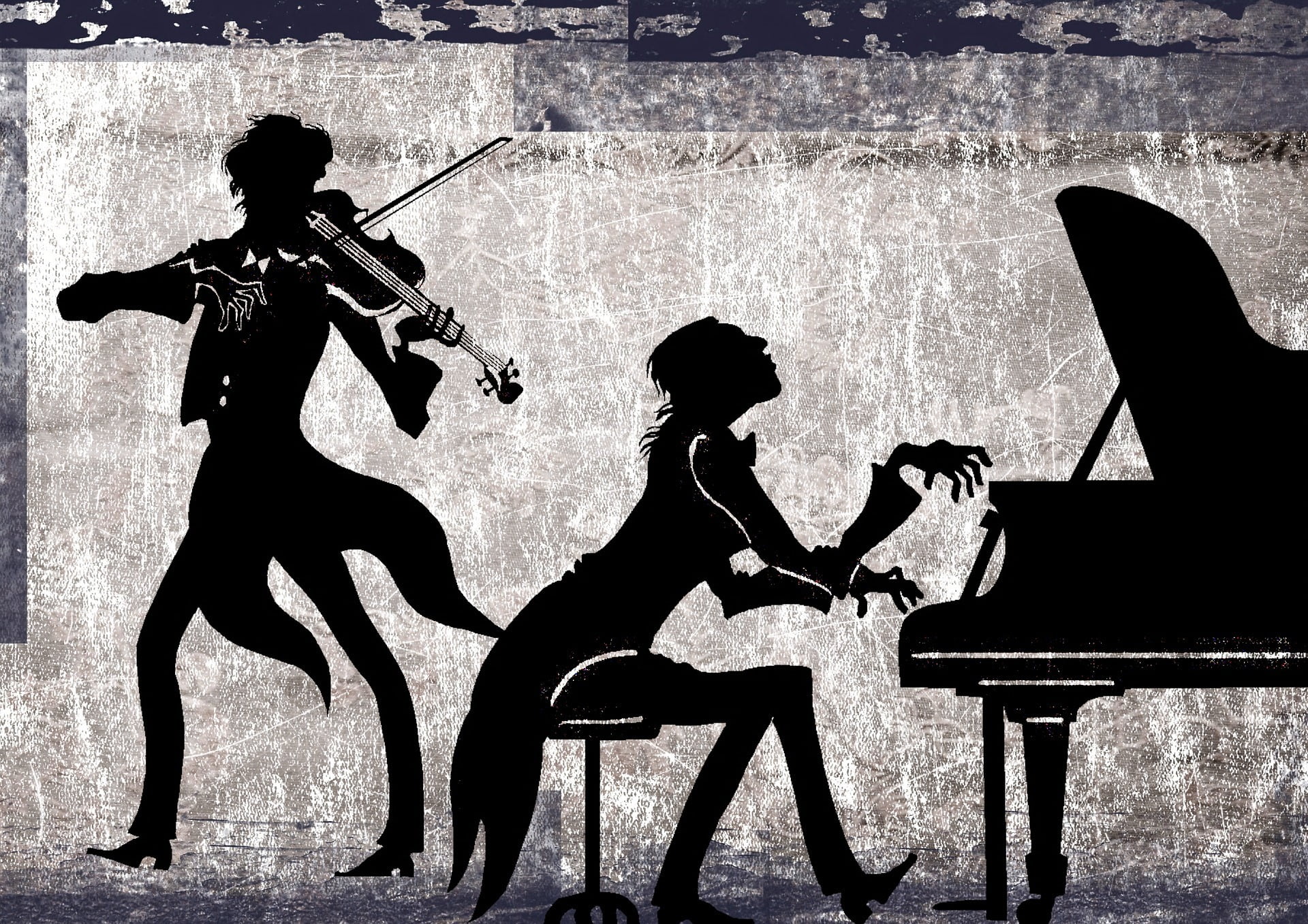
Learn How to Play Piano and Keyboard Step by Step
Getting Started
If you are a beginner and want to master the piano, you need to determine that this instrument is not a cakewalk. Although you sometimes see some prodigy pianists, most of us have to be ready to put in work.
Usually, people are curious about how much time it takes to learn to play piano and learn keyboard.
Actually, becoming “fluent” in keyboard or piano is personal. Some might take years while others just take a few months. So, how quickly you attain your music objectives mainly depends on you and how much effort, time, and practice you spend.
How to Start Learning Piano?
I honestly suggest you should practice for at least 30 minutes per day. It’s totally enough time to learn beginner piano lessons or consult a piano instruction from the piano tutor if necessary. You don’t need to spend too many hours every day but make sure you stay consistent while learning.
Choose a Right Piano
Choosing your first piano is one of the daunting and confusing tasks before starting beginner piano lessons. Try to answer some questions below so that you have a bright idea of a right piano!
- Which piano do you need? An acoustic piano or a digital one?
- Where will you place it?
- Who will be using it?
- How much money can you spend?

An acoustic piano can beat the others due to its perfect sound. However, if your house is small, you should consider it again because it’s too big and even comes with an expensive cost.
A beginner piano seems to be suitable for newbies because it’s quite cheap and offers great sound while playing.
Of course, it saves space as well. In case you decide to choose the beginner piano, you can buy an upright piano or consult the best quality digital piano for under 500 here to get more options.
Can You Learn Piano on a Keyboard?
This is a common question that many beginners wonder whether they can learn to play piano on an electric keyboard or organ.
In short, YES. However, the better answer needs more analysis into what kind of keyboard you have and what your plans for beginner piano lessons or keyboard lessons.
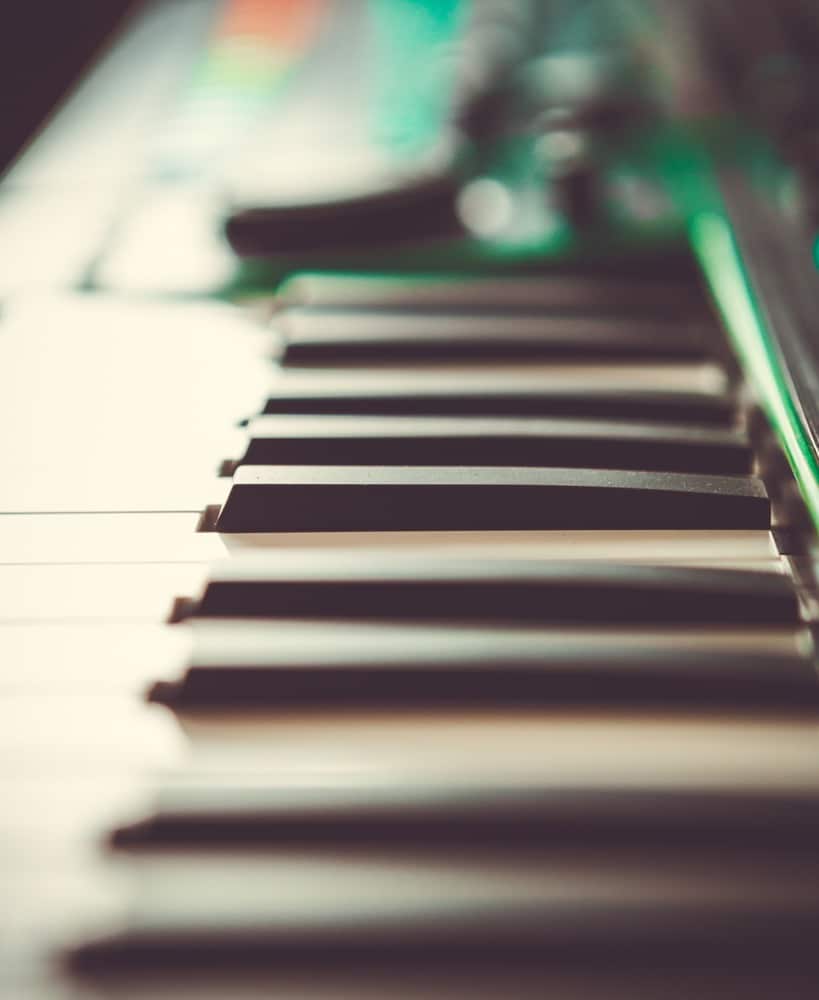
Here are two BIG notes that I want you to remember carefully.
- Most of the piano teachers agree that the fundamental key for a beginner is 88 ones. But, some organs don’t satisfy this.
- Besides, the weight of the key is necessary. If you’ve played a keyboard, you might realize that it’s easy to push the key. When playing the piano, you need to put more force to create a good sound.
Learning The Basic Concept
The basic concept for kids or for adults is to learn the musical alphabet. With seven notes including A, B, C, D, E, F, and G, all come in order from left to right and on the white keys on the keyboard. And after the G keys, the musical alphabet restarts at A.
How to determine the A keys?
Firstly, you need to find a group of three black keys on the keyboard. The “A” key is the white one between the second and third ones. As beginners, it’s best to label strips on each key so that you can recognize them in the first instance.
Getting Familiar with Your Notes
As a newbie, you are not familiar with music notes for sure. This is similar when you were a child and learned how to know letters of the alphabet.
But, allow me to show the right way so that you can learn piano notes well! Let’s begin with a simplified form – Do-Re-Mi-Fa-So-La-Si-Do. You know it, don’t you?
Sit in the middle of the piano and look for the C key on the keyboard. It’s the first white key to the left of a group of two black ones. Start practicing this form above and remember to sing it out loud.
Learn Your Keyboard and Your Piano Finger Numbers
Learning your piano finger numbers is a vital part of beginner piano lessons as well. Not only does it help beginners feel secure what finger to play a note with but also gives advanced players an understanding of how to play phrases.

Before learning to play piano with both hands, you need to determine the right-and-left-handed piano finger numbers. Each finger on both hands will be the same, including:
- The thumbs are always number 1.
- The index fingers are 2.
- The middle fingers are 3.
- The ring fingers are 4.
- The pinkies are 5.
Besides, you need to notice your natural hand position and hand posture on the keyboard.
Remember that the shorter fingers play longer keys; meanwhile, the longer fingers play the shorter keys.
The shorter fingers include the thumbs and pinkies, and the longer fingers include the index, middle, and ring fingers.
Learn The Piano Scale
The next important step in learning how to play piano and play keyboard is to learn the piano scale.
What is a scale? How many scales are there? How much importance are they? Down here to know now!
Introduction to Scales
A scale is defined as a group of notes that are connected to each other by pitch. It also offers the basic base for melody where every note is played individually and in harmony where more than two notes are performed at the same time.
According to the beginner piano lessons, individual scales are formed by applying a particular pattern to the chromatic scale. And this pattern is limited to a stable series of notes.
If you understand the relationships of the scales, it’s easy to comprehend the practical applications of melodies and chords as well as how combinations are used in music.
In this part, I will concentrate on two important scales including the Major Scale and the Minor Scale.
The Major Scale
The major scale is known as the most commonly used scales and is the first one you should learn to play piano or learn keyboard. Similar to any musical scales, it’s made up of seven notes.
One of the most straightforward major scales is the C major since it doesn’t have any sharps or flats.
Furthermore, it’s easy to perform because you only use the white keys. Its notes include C, D, E, F, G, A, B, and C; meanwhile, the eighth note of C is an octave higher.
The formula to create a major scale involves using whole steps and half steps. And it will be whole-whole-half-whole-whole-whole-half (W-W-H-W-W-W-H).
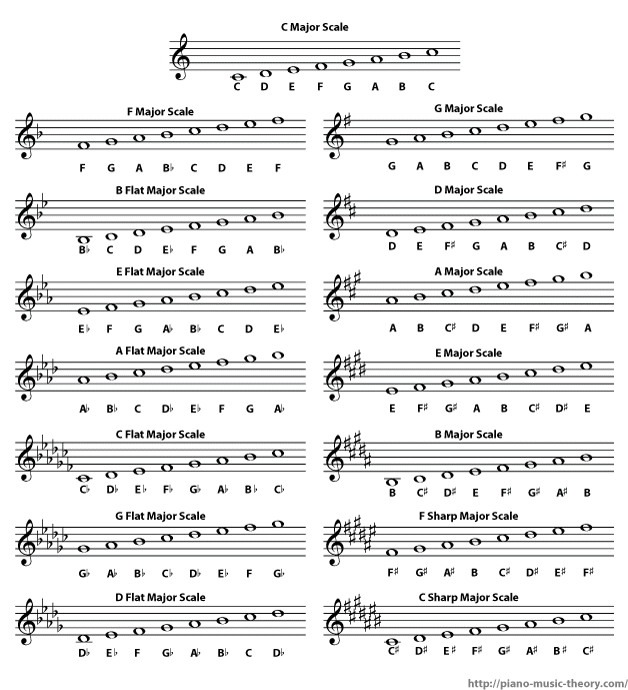
via piano-music-theory.com
Whole steps and half steps symbolize the distance between notes. For instance, the range between E and F is a half-step. Or the range between B and C is a half-step as well.
Then look at the piano keyboard, and you find out that there is no key between B and C as well as between E and F. So, C to D is a whole step, D to E is a whole step, F to G is a whole step and so on.
As long as you understand the basic formula of the major scale, you are able to begin on any note or key to creating a major scale.
How many major scales indeed? Well, there are 12 different ones involving 1 with no sharps and flats, 4 with sharps, 4 with flats, and 3 with either sharps and flats.
- C Major Scale = C – D – E – F – G – A – B – C
- D = D – E – F# – G – A – B – C# – D
- E = E – F# – G# – A – B – C# – D# – E
- F = F – G – A – Bb – C – D – E – F
- G = G – A – B – C – D – E – F# – G
- A = A -B – C# – D – E – F# – G# – A
- B = B – C# – D# – E – F# – G# – A# – B
- C#/Db = Db – Eb – F – Gb – Ab – Bb – C – Db
- D#/Eb = Eb – F – G – Ab – Bb – C – D – Eb
- F#/Gb = F# – G# – A# – B – C# – D# – F – F#
- G#/Ab = Ab – Bb – C – Db – Eb – F – G – Ab
- A#/Bb = Bb – C – D – Eb – F – G – A – Bb
The Minor Scale
Aside from the major scale, there is also the minor scale. And it includes eight notes beginning and ending on the same one.
The minor scale has three different types consisting of natural, harmonic, and melodic.
The natural minor scale is referred to as the minor scale.
Although some people often confuse this scale because it’s quite similar to the major scale, you can know the difference by viewing its formula.
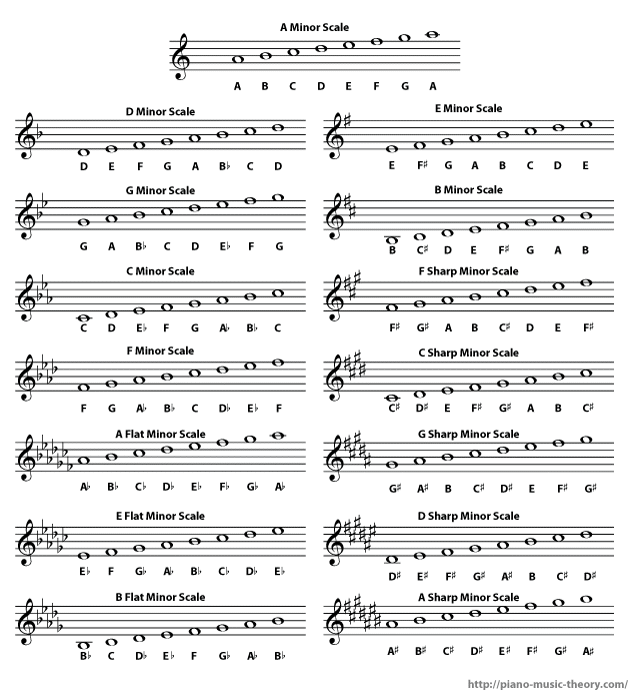
via piano-music-theory.com
The formula of the minor scale is whole-half-whole-whole-half-whole-whole (WHWWHWW). And to support you better, here are the minor scales in each key.
- A Minor Scale = A – B – C – D – E – F – G – A
- A#/Bb = A# – C – C# – D# – F – F# – G# – A#
- B = B – C# – D – E – F# – G – A – B
- C = C – D – Eb – F – G – Ab – Bb – C
- C# = C# – D# – E – F# – G# – A – B – C#
- D = D – E – F – G – A – Bb – C – D
- D#/Eb = D# – F – F# – G# – A# – B – C# – D#
- E = E – F# – G – A – B – C – D – E
- F = F – G – Ab – Bb – C – Db – Eb – F
- F#/Gb = F# – G# – A – B – C# – D – E – F#
- G = G – A – Bb – C – D – Eb – F – G
- G#/Ab = G# – A# – B – C# – D# – E – F# – G#
Just note a BIG difference between two scales is that the notes on the major scale sound cheerful and bright; meanwhile, the notes on the minor scale sound blue and solemn.
Learn The Piano Chord
After learning the piano scales, it’s time to continue diving into the basic rules of piano chords for beginners.
Piano chords are known as a set of three (or two) notes played at the same time. They have measured values and can be played soft or loud, slow or fast.
Even, you can learn to play piano chords with both hands simultaneously or with one hand while the other plays a melody.
Although there are various types of chords, one of the most common ones is Triads. Let’s learn what they are so that you can learn how to play piano chords well.

The Major Triad
First of all, you need to know that a triad is a musical chord including three notes (the first, third, and fifth notes in the major scale).
For example, if you want to play a C major triad, you should begin on a C note. Then reach the third note and fifth note in this scale in order to form a major triad.
Let’s give a clear look at all the major triads.
- C major triad = C – E – G
- G = G – B – D
- D = D – F# – A
- A = A – C# – E
- E = E – G# – B
- B = B – D# – F#
- F# = F# – A# – C#
- C# = C# – E# – G#
- F = F – A – C
- Bb = Bb – D – F
- Eb = Eb – G – Bb
- Ab = Ab – C – Eb
- Db = Db – F – Ab
- Gb = Gb – Bb – Db
- Cb = Cb – Eb – Gb
The Minor Triad
The second basic piano chord is the minor triad. It includes the first, flat third, and fifth notes in the major scale.
Although it’s a bit difficult, if you know how to play the major triad, it’s easy to play the minor one.
Of course, I also show a list of the minor triads so that you can learn to play piano chords.
- Cm minor triad = C – Eb – G
- Gm = G – Bb – D
- Dm = D – F – A
- Am = A – C – E
- Em = E – G – B
- Bm = B – D – F#
- F#m = F# – A – C#
- C#m = C# – E – G#
- Fm = F – Ab – C
- Bbm = Bb – Db – F
- Ebm = Eb – Gb – Bb
- Abm = Ab – B – Eb
- Dbm = Db – E – Ab
- Gbm = Gb – A – Db
- Cbm = Cb – D – Gb
The Other Diminished Triads
In a diminished triad, the third and fifth notes are flattened. And it’s stated as the symbol “dim” or “o.”
For instance, the C major triad is created by playing C, E, and G. When transferring to the C diminished triad, it will be C, E flat, and G flat.
Now, take a look at the remaining diminished triads below.
- C dim = C – Eb – Gb
- G dim = G – Bb – Db
- D dim = D – F – Ab
- A dim = A – C – Eb
- E dim = E – G – Bb
- B dim = B – D – F
- F# dim = F# – A – C
- Gb dim = Gb – A – C
- Db dim = Db – E – G
- C# dim = C# – E – G
- Ab dim = Ab – B – D
- Eb dim = Eb – Gb – A
- Bb dim = Bb – Db – E
- F dim = F – Ab – B
Except for the diminished triads, understanding augmented triads is also important when learning piano chords for beginners.
An augmented triad is a major triad with the fifth note raised a half step. And its symbol is often “aug” or “+.”
Down here to get a better view at all the augmented triads!
- C aug = C – E – G#
- G aug = G – B – D#
- D aug = D – F# – A#
- A aug = A – C# – F
- E aug = E – G# – C
- B aug = B – D# – G
- F aug = F# – A# – D
- Gb aug = Gb – Bb – D
- Db aug = Db – F – A
- C# aug = C# – E# (or F) – A
- Ab aug = Ab – C – E
- Eb aug = Eb – G – B
- Bb aug = Bb – D – F#
- F aug = F – A – C#
Watch this video to know clearly
Start Reading Music
I bet that learning music notes and symbols is one of the most challenging parts that every beginner feels anxious. But, since you’re here, I will show everything related to reading music.
Make sure you read all carefully, and I believe that you can play well soon. And maybe someday, looking in to a music sheet, you could even know best way to play it or what instrument fit perfectly with it, like in “The 4 Trombones” of Mozart’s sonata. Let’s dive right in
The Notes On The Treble Clef

via piano-lessons-made-simple.com
When starting reading music, any beginner piano lessons instruct you to encounter the clef. It looks like a big, fine and cursive sign at the far-left side.
And it tells you nearly what range your musical instrument will play.
The Treble Clef (also called G Clef) is originated from a decorative Latin letter G. An excellent way to remember it is that the G’s inner swoop encloses the “G” line on the staff.
What is staff? A staff includes five lines and four spaces, and each of lines and spaces corresponds with a different letter.
When notes are attached to the staff in the Treble Clef, they will be:
- The five lines represent the notes E G B D F (or you can remember a sentence like “Every Good Boy Does Fine.”).
- The four spaces represent the notes F A C E (just spell out the word “FACE”).
Notes and Rests Duration
The note duration is the length of time that a note is played; meanwhile, the rest duration is the length of the pause in a piece of music.
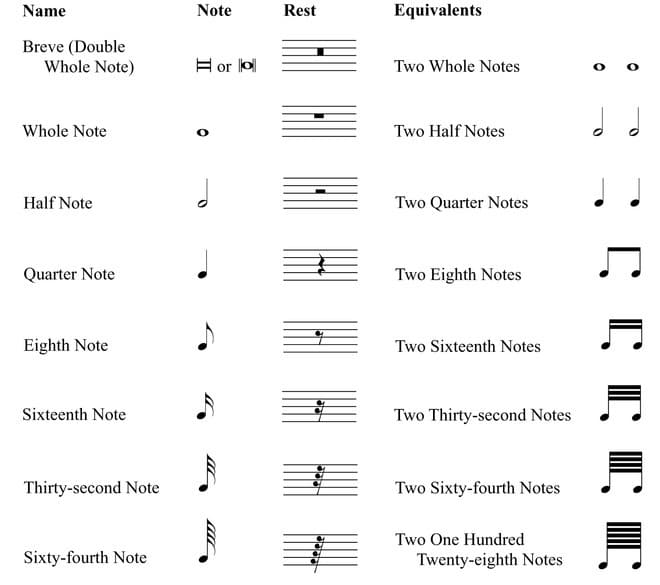
via musictheorytutoring.weebly.com
| Note Durations | Rest Durations | |
| Whole | It’s the longest note, and its duration is 4 quarter notes. | It has the same amount of time as a whole note. |
| Half | Its duration is 2 quarter notes. | Its length of the pause is equal to the half note’s duration. |
| Quarter | It’s a quarter (or a fourth) of a whole note. | It’s similar to the duration of the quarter note. |
| Eighth | It’s worth ½ of a quarter note. That means two eighth notes have the same amount of time as the one-quarter note. | The length of the pause of the eighth rest is equal to the eighth note. |
| Sixteenth | It’s worth ¼ of a quarter note. | It’s equal to the duration of the sixteenth note. |
| Thirty-second | It’s worth 1/32 of a whole note. | Its length of the pause is similar to the thirty-second note. |
| Sixty-fourth | It’s played for half the duration of a thirty-second note. | It has the same amount of time as the sixty-fourth note. |
| One hundred twenty-eighth | It’s worth 1/128 of a whole note. | It’s equal to the one hundred twenty-eighth note. |
Measures (bars)
A staff is actually not written as one long flow of musical symbols and signs. Instead, it’s separated into chunks, called measures (American) or bars (English).
Separating music into measures offers standard reference points for distinguishing locations within a piece of music.
Since each measure of staff symbols can be played as a group, you can read and follow the music with ease.
For instance, a song written in 3/4 time will hold three quarter note beats per measure. Meanwhile, a song written in 4/4 time holds four quarter note beats per measure.
Sharp and Flat Notes

via piano-tutorials.com
As outlined above, you might recognize sharp and flat notes when learning how to play piano scales and chords. But, in this part, I will explain clearly.
A sharp note means to advance a half step while a flat note means to back a half step.
What is a half step?
A half step is defined as the distance between a key (black or white) on the keyboard and the key that is next to it.
Take a look at this example to understand better!
The white keys beginning on C follow an order C, D, E, F, G, A, and B. So, the black keys to the immediate right of C is C sharp.
In this case, if you play the Db major scale, D flat is played the same key as C sharp.
Why? It’s because when playing C sharp, you go up by a half step. Meanwhile, you have to go down by a half step to play D flat
All in all, just keep in mind that sharp means to move to the next key on the right and flat mean to play the following key on the left.
The Notes on The Bass Clef

via fretboard.com
The bass clef (also called the F clef) is used in the lower registers such as the left hand of the piano, tuba or cello, bass guitar, bassoon, trombone, etc.
When the notes are added to the staff in the bass clef, they will be:
- The five lines represent the notes G B D F A (or you can remember a sentence like “Good Boys Don’t Fool Around.”).
- The four spaces represent the notes A C E G (or bear in mind this sentence “All Cows Eat Grass.”).
Play Treble and Bass Clef Together
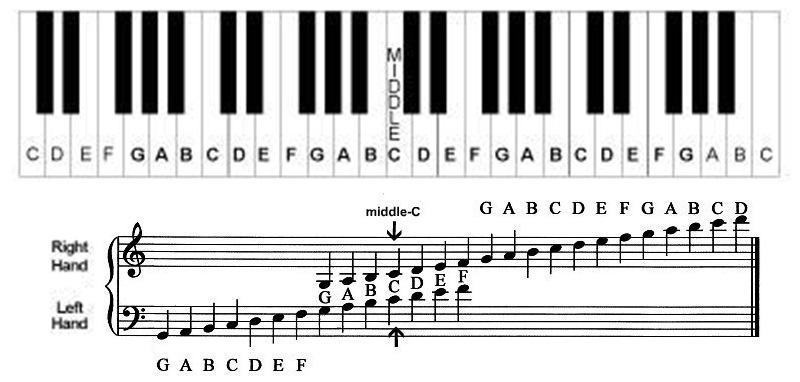
via keytarhq.com
Many people affirm that practicing the notes on the treble clef is easier than the bass clef due to their different positions.
If you want to play both together well, follow my guide and start practicing.
- You need to have a general look at both clefs on the keyboard.
- Then practice with each hand, particularly the right hand firstly.
- Remember to label white spaces with E G B D F and F A C E for the treble clef.
- Of course, you should do the similar thing for the bass clef.
- Select easy piano songs that allow both hands together.
- Practicing more and more is a key.
Sheet Music, Lead Sheet, and Chord Sheet
If you want to learn to play piano or learn keyboard, you need to understand different definitions of sheet music, lead sheet, and chord sheet as well.
- A sheet music is defined as a form of music notation that has musical symbols to illustrate melodies, rhythms or chords of a song.
- A lead sheet mainly includes a notated melody with chord signs above. Basically, your right hand will play the melody while the left hand plays the chord signs.
- A chord sheet simply has chord signs without notations. The chord sheet is designed to use for accompaniment. That means the pianist uses the chord sheet to accompany other instrumentalists or a singer.
Lesson And Practicing
It’s time to revise all the steps above and start practicing playing keyboard day by day.

Try to spend at least 30 minutes per day to play and develop your skills. Continue memorizing where the notes are and practice more complicated scales and chords.
Don’t forget to search “free keyboard lessons” or “music lesson for beginners” or “first piano lesson” online or simply consider hiring a music teacher to help you.
What Should Beginner Listen And Learn?
When mastering piano sheet music isn’t for everyone, some tend to play a piano by ear. No matter who you are a newbie or pro, it’s something you can do.
The first and foremost thing is to train your ear by listening to a piano song over and over again. Do until you can sing it correctly with no musical backing.
Then try to match the notes with the key on the piano. It will be challenging at first, but you’ll find yourself realizing the sounds better over time.
Do it slowly, practice with some notes at a time, and try to remember them.
Another right way that you can learn to play piano or play keyboard by ear is to play a game with your friend.
Ask him/her to tap two keys on the piano, and then you guess whether the first note is lower or higher than the second one.
This way helps to improve your listening skill and recognize the notes within a piano song with ease.
Is Online Piano Tutorial Good for The Beginner?
Yes, it is. You can learn to play piano online or register a piano course to learn beginner piano lessons easily.
All in all, you just keep learning necessary lessons and practicing frequently, success will be yours.
And soon you recognize that you can play any music like Jazz, Blue, etc. or even perform a piano improvisation without seeing any sheet music.
Conclusion
Learning how to play piano and keyboard for dummies is tough for sure. However, with the basics above, I believe that you get a good background of this instrument.
Don’t forget to jot down anything that you don’t understand or make a binder to gather great sheet music, notes, tips, and tricks.
And remember that when you first learn to play piano and learn keyboard, it always takes times to accustomed to playing on both hands together.
Just keep practicing all the times, permit yourself to improve coordination and dexterity, and then you will realize that how fast you develop.
Last but not least, if you still have queries related to this topic, don’t mind leaving your comments in the box below so that we can discuss together.
Or in case you like this post, please SHARE it with those who truly need it.
Once again, thanks for reading!